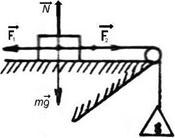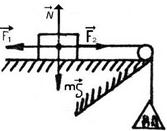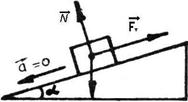
CATEGORIES:
BiologyChemistryConstructionCultureEcologyEconomyElectronicsFinanceGeographyHistoryInformaticsLawMathematicsMechanicsMedicineOtherPedagogyPhilosophyPhysicsPolicyPsychologySociologySportTourism
Frictional forces
If we project a block of mass m with initial velocity v0 along a long horizontal table, it eventually comes to rest. This means that, while it is moving, it experiences an average acceleration <a> that points in the direction opposite to its motion. In this case we declare that the table exerts a force of friction, F whose average value is m<a> on the sliding block. The frictional force on each body is in a direction opposite to its motion relative to the other body.
The frictional forces acting between surfaces at rest with respect to each other are called forces of static friction. The maximum force of static friction will be the same as the smallest force necessary to start motion.
The forces acting between surfaces in relative motion are called forces of kinetic friction.

Figure 4.1
The maximum force of static friction between any pair of dry unduplicated surfaces follows these two empirical laws:
- It is approximately independent of the area of contact, over wide limits.
- It is proportional to the normal force.
The ratio of the magnitude of the maximum force of static friction to the magnitude of the normal force is called the coefficient of static friction for the surfaces involved. We can write
fs  sN . (4.13)
sN . (4.13)
The force of kinetic friction fk between dry unlubricated surfaces follows two laws:
- it is approximately independent of the area of contact over wide limits;
- it is proportional to the normal force:
fk  kN, (4.14)
kN, (4.14)
 k is the coefficient of kinetic friction.
k is the coefficient of kinetic friction.




Figure 4.2
Date: 2015-01-12; view: 1188
| <== previous page | | | next page ==> |
| Circular Motion of a Particle | | | Gravitational force |